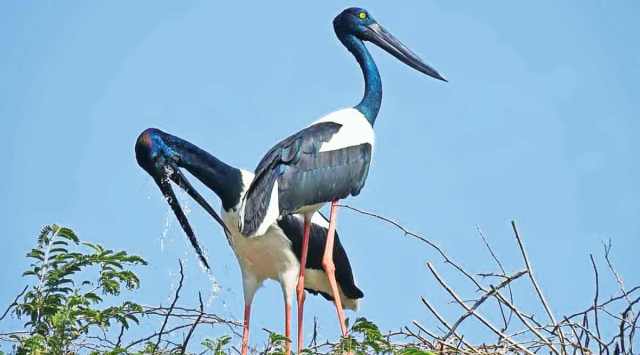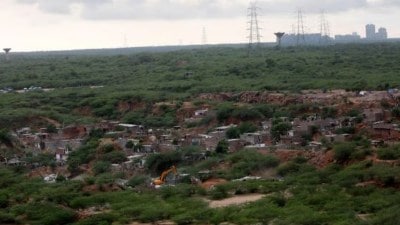Bird census: Black-necked stork sighted in Porbandar for second year
Led by Ramde Bhatiya, a team of birdwatchers comprising Batuk Bhil, Paresh Pitroda and Ramesh Gouvadkar, sighted a female black-necked stork (BNS) in the Bardasagar reservoir while counting birds on the second day of the Bird Count Porbandar Wetlands organised by the BCSG.
 Birds of this species are also sighted in Bharuch, Vadodara, Polo Forest in Sabarkantha and Kutch. (File)
Birds of this species are also sighted in Bharuch, Vadodara, Polo Forest in Sabarkantha and Kutch. (File) The black-necked stork was recorded for the second consecutive year in Porbandar, while two tagged demoiselle cranes were also sighted during a two-day bird count that concluded in Porbandar Sunday.
Led by Ramde Bhatiya, a team of birdwatchers comprising Batuk Bhil, Paresh Pitroda and Ramesh Gouvadkar, sighted a female black-necked stork (BNS) in the Bardasagar reservoir while counting birds on the second day of the Bird Count Porbandar Wetlands organised by the Bird Conservation Society of Gujarat (BCSG). “We were winding up our bird counting session when we focused our attention on the other side of the mud track we had been traversing and spotted a female BNS resting on a dry mudflat,” Bhatiya, a mathematic and science teacher at a government primary school and who has been birdwatching for the past 12 years, said. In February last year, too, a BNS was recorded in Gosabara-Mokar Sagar wetland complex during a bird count organised by BCSG.
“The second sighting in as many years in Porbandar means that these birds do live here even though their numbers could be very few,” Dhaval Vargiya, president of Mokar Sagar Wetland Conservation Committee (MWCC)—a Porbandar-based NGO and Gujarat state coordinator of Asian Waterbird Census, said.
BNS (Ephippiorhynchus asiaticus) is categorised as a near-threatened species on the Red List of the International Union for Conservation of Nature (IUCN) due to its declining population trend globally largely on account of habitat loss. It is considered a rare bird in Gujarat due to its small population size.
The Khijadiya Bird Sanctuary near Jamnagar and the Marine National Park along the coast of Jamnagar and Devbhumi Dwarka district harbour the largest population of BNS in Gujarat. The species has been breeding successfully in Khijadiya, a Ramsar site, as well as in the coastal wetland area.
Birds of this species are also sighted in Bharuch, Vadodara, Polo Forest in Sabarkantha and Kutch. They are also occasionally sighted at Nal Sarovar Bird Sanctuary, another Ramsar site, in the state.
Vargiya said the aerial distance between Bardasagar and Gosabara-Mokar Sagar is around 40 kilometres and occasional sightings of BNS have been recorded in Porbandar over the past one decade.
The bird count was conducted in collaboration with the Gujarat forest department and was sponsored by the Saurashtra Chemicals Limited, Porbandar. Seventeen teams comprising 68 birdwatchers estimated the population of waterbirds in different wetlands cumulatively spread over 200 square kilometres. Last year’s count had recorded around 3.26 lakh birds of 117 species.
Meanwhile, another team led by Yashodhan Bhatia saw two demoiselle cranes with tags in the Mendha creek area Sunday morning. “We were returning to Porbandar after counting birds in the wetland when we saw a flock of around 250 cranes roosting by the side of the highway. We noted that one of the demoiselle cranes had a GPS-tracking device on its left leg and a green-coloured ring bearing code name H13 on its right leg. Another crane had a similar ring with code name Y94,” Bhatia, a birdwatcher from Jamnagar, said. Bhatia’s team comprised Ashish Pankhaniya, Hemant Vadhvana and Sudip Simha.
Porbandar is a major wintering ground for the demoiselle crane population that breeds in central Asia. “Given the colour of the rings and code names, it appears that these demoiselle cranes were tagged in Mongolia,” Bhatia said.
During the waterfowl census, wildlife biologist Bharat Jethva and flamingo-expert Anika Tere also recorded mallards—a migratory duck species considered a rare sighting in the state. Birdwatchers also spotted grey-bellied cuckoo and chestnut-tailed starling, both species not common during this time of the year in Porbandar.







